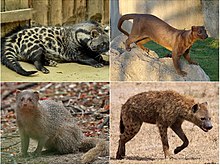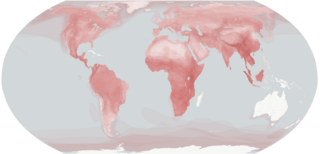
Carnivora is an order of placental mammals that have specialized in primarily eating flesh, whose members are formally referred to as carnivorans. The order Carnivora is the fifth largest order of mammals, comprising at least 279 species.
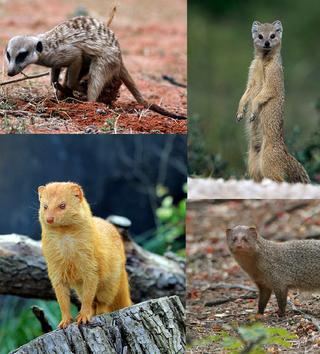
A mongoose is a small terrestrial carnivorous mammal belonging to the family Herpestidae. This family is currently split into two subfamilies, the Herpestinae and the Mungotinae. The Herpestinae comprises 23 living species that are native to southern Europe, Africa and Asia, whereas the Mungotinae comprises 11 species native to Africa. The Herpestidae originated about 21.8 ± 3.6 million years ago in the Early Miocene and genetically diverged into two main genetic lineages between 19.1 and 18.5 ± 3.5 million years ago.

Viverridae is a family of small to medium-sized, feliform mammals. The viverrids comprise 33 species placed in 14 genera. This family was named and first described by John Edward Gray in 1821. Viverrids occur all over Africa, southern Europe, and South and Southeast Asia, across the Wallace Line.
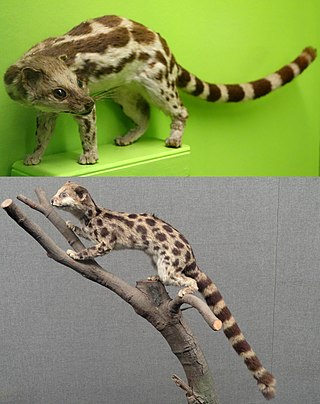
The Asiatic linsang (Prionodon) is a genus comprising two species native to Southeast Asia: the banded linsang and the spotted linsang. Prionodon is considered a sister taxon of the Felidae.
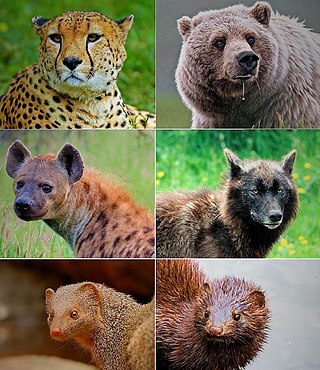
Fissipedia is a former suborder of placental mammals comprising the largely land-based families of the order Carnivora. In some former taxonomic classifications, Pinnipedia is treated as an suborder in order Carnivora along side Fissipedia and Creodonta,. rather than as a sugroup of "dog-like" carnivorans.

Caniformia is a suborder within the order Carnivora consisting of "dog-like" carnivorans. They include dogs, bears, raccoons, and mustelids. The Pinnipedia are also assigned to this group. The center of diversification for the Caniformia is North America and northern Eurasia. Caniformia stands in contrast to the other suborder of Carnivora, the Feliformia, the center of diversification of which was in Africa and southern Asia.

Viverravidae is an extinct monophyletic family of mammals from extinct superfamily Viverravoidea within the clade Carnivoramorpha, that lived from the early Palaeocene to the late Eocene in North America, Europe and Asia. They were once thought to be the earliest carnivorans and ancestral to extant ones, but now are placed outside the order Carnivora based on cranial morphology as relatives to extant carnivorans.

A genet is a member of the genus Genetta, which consists of 17 species of small African carnivorans. The common genet is the only genet present in Europe and occurs in the Iberian Peninsula, Italy and France.
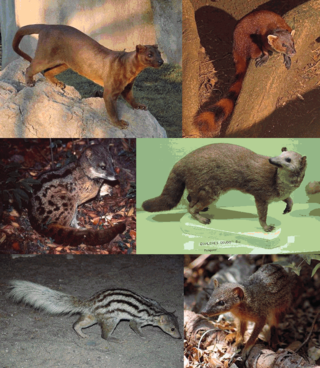
Eupleridae is a family of carnivorans endemic to Madagascar and comprising 10 known living species in seven genera, commonly known as euplerids, Malagasy mongooses or Malagasy carnivorans. The best known species is the fossa, in the subfamily Euplerinae. All species of Euplerinae were formerly classified as viverrids, while all species in the subfamily Galidiinae were classified as herpestids.

Galidiinae is a subfamily of carnivorans that is restricted to Madagascar and includes six species classified into four genera. Together with the three other species of indigenous Malagasy carnivorans, including the fossa, they are currently classified in the family Eupleridae within the suborder Feliformia. Galidiinae are the smallest of the Malagasy carnivorans, generally weighing about 600 to 900 g. They are agile, short-legged animals with long, bushy ringed tails.

Feliformia is a suborder within the order Carnivora consisting of "cat-like" carnivorans, including cats, hyenas, mongooses, viverrids, and related taxa. Feliformia stands in contrast to the other suborder of Carnivora, Caniformia.

The Viverrinae represent the largest subfamily of the Viverridae comprising three genera, which are subdivided into six species native to Africa and Southeast Asia. This subfamily was denominated and first described by John Edward Gray in 1864.

Paradoxurinae is a subfamily of the feliform viverrids that was denominated and first described by John Edward Gray in 1864. Pocock subordinated the genera Paradoxurus, Paguma and Arctictis to this subfamily.

Bourlon's genet is a genet species native to the Upper Guinean forests. It is known from only 29 zoological specimens in natural history museum and has been described as a new Genetta species in 2003. It is listed as Vulnerable on the IUCN Red List as the global population is estimated at less than 10,000 mature individuals.

Stenoplesictidae is the name of a polyphyletic family of extinct civet-like feliforms.
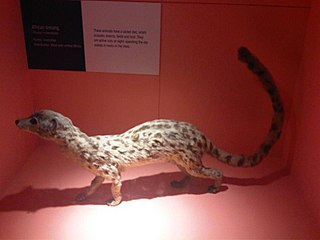
The African linsangs also known as oyans are two species classified in the mammalian subfamily Viverrinae, in the family Viverridae. There is one genus, Poiana.
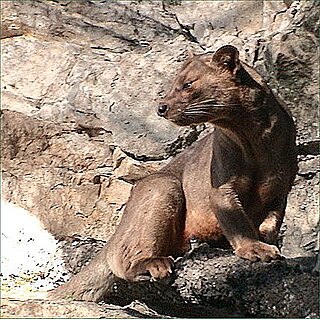
Euplerinae, more commonly known as malagasy civets, is a subfamily of carnivorans that includes four species restricted to Madagascar. Together with the subfamily Galidiinae, which also only occurs on Madagascar, it forms the family Eupleridae. Members of this subfamily, which include the fossa, falanoucs and Malagasy civet, were placed in families like Felidae and Viverridae before genetic data indicated their consanguinity with other Madagascar carnivorans. Within the subfamily, the falanouc and Malagasy civet are more closely related to each other than to the fossa.
Anictis is an extinct species of carnivorous cat-like mammal belonging to the superfamily Aeluroidea, endemic to Europe living from the Oligocene 33.9—28.4 Ma, existing for approximately 5.4 million years.

Stenoplesictis is an extinct genus of carnivorous cat-like mammals belonging to the superfamily Aeluroidea, from Europe and Asia (Mongolia), from the Oligocene 33.9—28.4 Ma, existing for about 5.5 million years.

Herpestoidea is a superfamily of mammalia carnivores which includes mongooses, Malagasy carnivorans and the hyenas.
